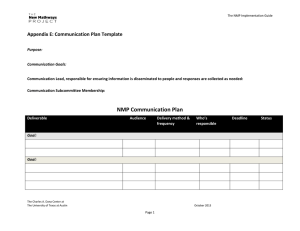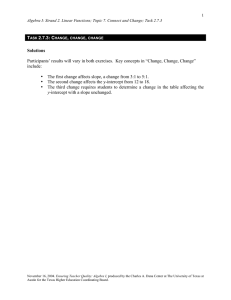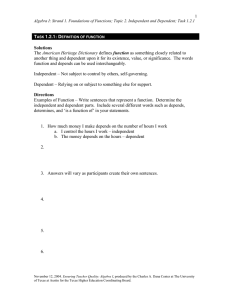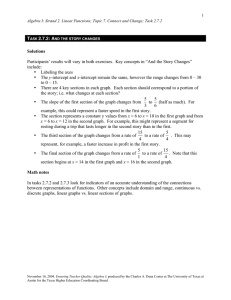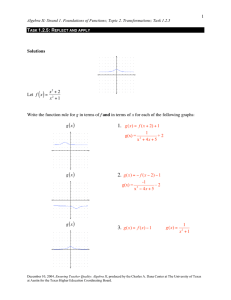Essential Science Concepts for Exit-Level TAKS: Hands-On Activities for Supporting Student Success
advertisement
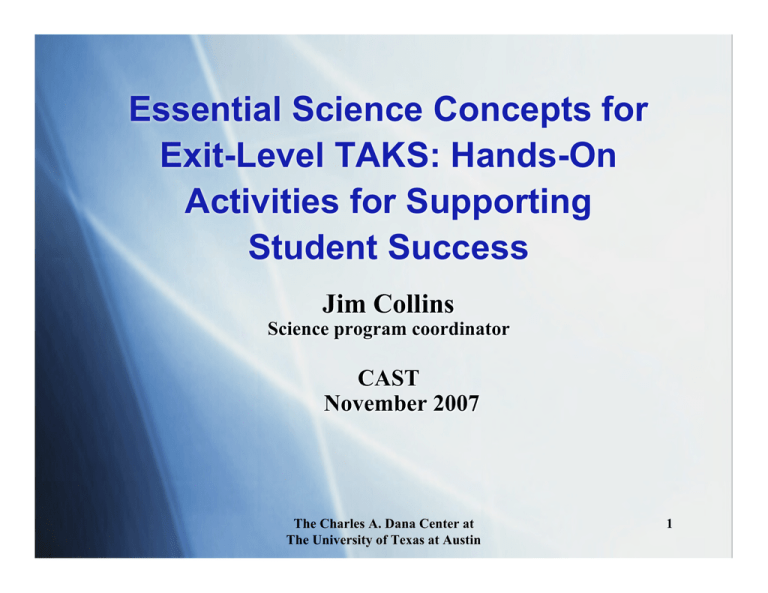
Essential Science Concepts for Exit-Level TAKS: Hands-On Activities for Supporting Student Success Jim Collins Science program coordinator CAST November 2007 The Charles A. Dana Center at The University of Texas at Austin 1 Diamond Reflection Please fill out the upper left portion— I came expecting… The Charles A. Dana Center at The University of Texas at Austin 2 What are the Essential Science Concepts for Exit-Level TAKS (ESCET) modules? The ESCET program consists of an Integrated Physics and Chemistry module and a Biology module. Each module • reviews the science concepts tested on exit-level TAKS • engages students in hands-on investigations • integrates scientific process skills into each activity The Charles A. Dana Center at The University of Texas at Austin 3 Are the Essential Science Concepts a teaching tool? The Essential Science Concepts modules are designed as tool for content review and reinforcement. They are not intended as teaching materials for students unfamiliar with the concepts covered in the activities. The Charles A. Dana Center at The University of Texas at Austin 4 Who should use the modules? ESCET modules can be used by school districts searching for an alternative method to prepare students for success on the exit-level TAKS. The Charles A. Dana Center at The University of Texas at Austin 5 How are the modules structured? Each module • contains a series of station activities focused on science concepts that are tested on the exit-level TAKS. • provides a sufficient number of activities for four class periods. The Charles A. Dana Center at The University of Texas at Austin 6 TAKS science objectives and TEKS student expectations addressed in the modules TA KS Objective Objective 1* Integrated Physics and Chemistry 1(A) 2(A)(B)(C)(D) 3(A)(B) Biology 1(A) 2(A)(B)(C)(D) Objective 2 4(B) 6(A)(B)(C) 8(C) 10(A)(B) Objective 3 4(C)(D) 7(A)(B) 9(D) 12(B)(E) 13(A) Objective 4 Objective 5 7(A)(D) 8(A)(C) 9(A)(B)(D) 4(A)(B)(D) 5(B) 6(A)(B)(D) The Charles A. Dana Center at The University of Texas at Austin *Objective 1: The student will demonstrate an understanding of the nature of science. These student expectations will be included in the station activities and not addressed in isolation. 7 How is each station activity structured? Each activity is divided into… • Teacher pages • Blackline masters • Student pages The Charles A. Dana Center at The University of Texas at Austin 8 Teacher Pages The teacher pages include… • Station activity title • Purpose • Correlations to the TEKS • Teacher Notes About the TEKS • Background Information for the Teacher • Resources The Charles A. Dana Center at The University of Texas at Austin 9 Teacher Pages (continued) The teacher pages include… • Materials • Advance Preparation • Station Setup • Procedures • Guide to Student Responses The Charles A. Dana Center at The University of Texas at Austin 10 Blackline Masters The pages provided in the blackline masters vary with each activity. Generally, the blackline masters include… •Station information sheet •Station mat (not included in every activity) •Other materials such as cards, data tables, images, photographs, etc. •Student pages •Glossary The Charles A. Dana Center at The University of Texas at Austin 11 Student Pages The student pages include… • Before You Begin… • Materials • Procedures • Questions • Question Card • I Need to Remember • Glossary The Charles A. Dana Center at The University of Texas at Austin 12 How should the modules be implemented? You have choices. One is to administer the modules separately. The ESCET modules can be administered separately (all Biology activities together and all IPC activities together). The Charles A. Dana Center at The University of Texas at Austin 13 How should the modules be implemented? Administering modules separately Example with selected stations; in practice you could use a larger mix of stations. The Charles A. Dana Center at The University of Texas at Austin 14 How should the modules be implemented? Administering integrated modules Alternatively, you can implement one IPC activity followed by one Biology activity, and so on, so that the activities are integrated in the same way the TAKS integrates the Biology and IPC questions. The Charles A. Dana Center at The University of Texas at Austin 15 How should the modules be implemented? Administering integrated modules Example with selected stations; in practice you could use a larger mix of stations. The Charles A. Dana Center at The University of Texas at Austin 16 Moving through the station activities Students should work in small groups—preferably teams of two. Once students have received a study folder they are to begin the station activities. They will examine the station information sheet at the table and verify the setup, read and answer the Focus Question, follow the procedures in the student pages to work through the activity answer the TAKS question on the Question Card post their answer on the diagnostic wall chart The Charles A. Dana Center at The University of Texas at Austin 17 How should the diagnostic wall chart be used? The diagnostic wall chart will contain each student team’s answers to the TAKS question card for each station. The diagnostic chart is designed to help the teacher quickly assess the concepts that students are successful with and the concepts that need further review. The Charles A. Dana Center at The University of Texas at Austin 18 Overview of the Activities The Charles A. Dana Center at The University of Texas at Austin 19 Biology Station 4(B), Part II: Cell Functions Purpose: The purpose of this station is to reinforce students’ understanding of the structures and functions of plant and animal cell parts. The Charles A. Dana Center at The University of Texas at Austin 20 IPC Station 4(A): Speed and Momentum Purpose: The purpose of this station is to reinforce students’ understanding of speed and momentum. The Charles A. Dana Center at The University of Texas at Austin 21 Biology Station 4(C): Structure and Infectious Behavior of Viruses Purpose: The purpose of this station is to reinforce students’ understanding of the structure of a virus and how viruses cause diseases. The Charles A. Dana Center at The University of Texas at Austin 22 IPC Station 4(B): Newton’s Laws of Motion Purpose: The purpose of this station is to reinforce students’ understanding of Newton’s laws of motion. The Charles A. Dana Center at The University of Texas at Austin 23 Biology Station 4(D), Part I: Bacteria and Health Purpose: The purpose of this station is to reinforce students’ understanding of the role of bacteria in maintaining health. The Charles A. Dana Center at The University of Texas at Austin 24 IPC Station 4(D): Efficiency in Machines Purpose: The purpose of this station is to reinforce students’ understanding of how the efficiency of a machine can change. The Charles A. Dana Center at The University of Texas at Austin 25 Biology Station 4(D), Part II: Bacteria and Disease Purpose: The purpose of this station is to reinforce students’ understanding of the role of bacteria in maintaining health in living organisms and in causing disease. The Charles A. Dana Center at The University of Texas at Austin 26 IPC Station 5(B), Part I: Reflection and Refraction Purpose: The purpose of this station is to reinforce students’ understanding of ways that waves interact with their surroundings through reflection and refraction. The Charles A. Dana Center at The University of Texas at Austin 27 Biology Station 6(A): DNA Purpose: The purpose of this station is to reinforce students’ understanding of the structure of DNA and protein synthesis (transcription and translation). The Charles A. Dana Center at The University of Texas at Austin 28 IPC Station 5(B), Part II: Diffraction and Resonance Purpose: The purpose of this station is to reinforce students’ understanding of waves in everyday life and how waves can be diffracted and resonated. The Charles A. Dana Center at The University of Texas at Austin 29 Biology Station 6(B): Protein Synthesis Purpose: The purpose of this station is to reinforce students’ understanding of the structure of DNA and protein synthesis (transcription and translation). The Charles A. Dana Center at The University of Texas at Austin 30 IPC Station 6(B): Heat Transfer Purpose: The purpose of this station is to reinforce students’ understanding that heat can move through solids, liquids, and gases by various means. The Charles A. Dana Center at The University of Texas at Austin 31 Biology Station 7(B): Natural Selection Purpose: The purpose of this station is to reinforce students’ understanding of the results of change in species. The Charles A. Dana Center at The University of Texas at Austin 32 IPC Station 6(D): Energy Sources and Their Impact Purpose: The purpose of this station is to reinforce students’ understanding of the impact that energy transformations have on economic and environmental aspects of everyday life. The Charles A. Dana Center at The University of Texas at Austin 33 Biology Station 10(B): Interrelationships Among Organ Systems Purpose: The purpose of this station is to reinforce students’ understanding of how organ systems in living organisms interrelate with one another. The Charles A. Dana Center at The University of Texas at Austin 34 IPC/Biology Station 1(A): Laboratory Safety Purpose: The purpose of this station is to reinforce students’ understanding of safety procedures and equipment that must be used during laboratory investigations. The Charles A. Dana Center at The University of Texas at Austin 35 IPC Station 6(A): Conservation of Energy Purpose: The purpose of this station is to reinforce students’ understanding of energy transformations. The Charles A. Dana Center at The University of Texas at Austin 36 Biology Station 4(B): Cellular Processes Purpose: The purpose of this station is to reinforce students’ understanding of osmosis as a cellular process. The Charles A. Dana Center at The University of Texas at Austin 37 IPC Station 7(A): Density, Viscosity and Buoyancy Purpose: The purpose of this station is to reinforce students’ understanding of density, viscosity, and buoyancy. The Charles A. Dana Center at The University of Texas at Austin 38 Biology Station 4(B) III: Photosynthesis and Cell Respiration Purpose: The purpose of this station is to reinforce students’ understanding of energy production in photosynthesis and cell respiration. The Charles A. Dana Center at The University of Texas at Austin 39 IPC Station 7(D): Chemical Behavior and the Periodic Table Purpose: The purpose of this station is to reinforce students’ understanding of the relationships that exist between the chemical behavior of an element and its position on the periodic table. The Charles A. Dana Center at The University of Texas at Austin 40 Biology Station 7(A): Evidence of Change Purpose: The purpose of this station is to reinforce students’ understanding of the evidence of change in species. The Charles A. Dana Center at The University of Texas at Austin 41 IPC Station 8(A): Physical and Chemical Changes Purpose: The purpose of this station is to reinforce students’ understanding of the difference between physical and chemical changes in everyday examples. The Charles A. Dana Center at The University of Texas at Austin 42 Biology Station 8(C): Classification and Taxonomy Purpose: The purpose of this station is to reinforce students’ understanding of a biological classification system. The Charles A. Dana Center at The University of Texas at Austin 43 IPC Station 8(C): Conservation of Mass Purpose: The purpose of this station is to reinforce students’ understanding of the law of conservation of mass. The Charles A. Dana Center at The University of Texas at Austin 44 Biology Station 9(D): Energy Flow Within Ecosystems Purpose: The purpose of this station is to reinforce students’ understanding of the flow of energy and matter through organisms and their environment. The Charles A. Dana Center at The University of Texas at Austin 45 IPC Station 9(A): Structure and Function of Water Purpose: The purpose of this station is to reinforce students’ understanding of the structure of water and its function as the universal solvent. The Charles A. Dana Center at The University of Texas at Austin 46 Biology Station 10(A): Systems in Organisms Purpose: The purpose of this station is to reinforce students’ understanding of the functions of systems found in living organisms. The Charles A. Dana Center at The University of Texas at Austin 47 IPC Station 9(B): Concentration of Ions in Solution Purpose: The purpose of this station is to reinforce students’ understanding of how certain chemical and physical properties are related to the concentration of ions in solution. The Charles A. Dana Center at The University of Texas at Austin 48 Biology Station 12(B): Interdependence and Interactions Purpose: The purpose of this station is to reinforce students’ understanding of the interactions that occur among organisms in an ecosystem. The Charles A. Dana Center at The University of Texas at Austin 49 IPC Station 9(D): Factors Influencing Solubility Purpose: The purpose of this station is to reinforce students’ understanding of how various factors influence solubility. The Charles A. Dana Center at The University of Texas at Austin 50 Biology Station 12(E): Food Chains, Food Webs, and Energy Pyramids Purpose: The purpose of this station is to reinforce students’ understanding of the interactions that can occur between a variety of organisms in an ecosystem. The Charles A. Dana Center at The University of Texas at Austin 51 Biology Station 13(A): Plant Adaptations Purpose: The purpose of this station is to reinforce students’ understanding of the importance of structural and physiological adaptations of plants. The Charles A. Dana Center at The University of Texas at Austin 52 Day 1 Rotation Follow these steps at each station… 3 minutes: Read over the activity. 10 minutes: Work through the student pages and answer all the questions. 2 minutes: Discuss the prior knowledge a student needs to be successful at the station. The Charles A. Dana Center at The University of Texas at Austin 53 Discuss the activity at your station As a table, make a poster that includes the following… • Title the poster with the name and TEKS number of the activity at your station. • List what prior knowledge students will need to be successful at this station. • List the vocabulary (science and nonscience) that students will need to understand the activity. The Charles A. Dana Center at The University of Texas at Austin 54 Day 2 Rotation Follow these steps at each station… 3 minutes: Read over the activity. 10 minutes: Work through the student pages and answer all the questions. 2 minutes: Add to the poster for your table. The Charles A. Dana Center at The University of Texas at Austin 55 Diamond Reflection Please complete the other sections of your Diamond Reflection and leave them on your table at the end of the session. The Charles A. Dana Center at The University of Texas at Austin 56 Contact Information Jim Collins jwcollins@mail.utexas.edu www.utdanacenter.org www.sciencetekstoolkit.org The Charles A. Dana Center at The University of Texas at Austin 57
